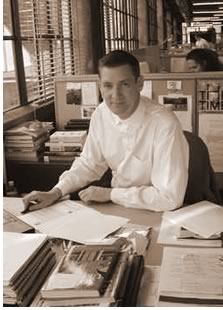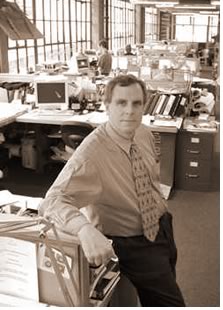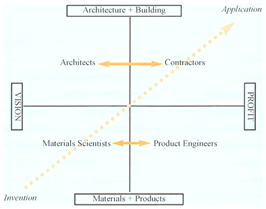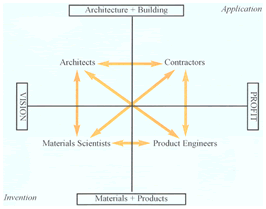
Materials and Process
KieranTimberlake Associates Awarded Inaugural COF Latrobe Fellowship

 KieranTimberlake
Associates, Philadelphia, is embarking on a journey to boldly go where
no architecture firm has gone before. The firm's roadmap for this trip
is a proposal for a two-year research project, "Masters(s) Building
in 2010: Architecture, Construction, and Production." The proposal—for
which the AIA College of Fellow's awarded its inaugural Latrobe Fellowship,
named for Benjamin Latrobe, America's first professional architect, and
awarded for research leading to significant advances in the profession—"seeks
to provide direction toward a brave new world of conceptualizing and constructing
architecture."
KieranTimberlake
Associates, Philadelphia, is embarking on a journey to boldly go where
no architecture firm has gone before. The firm's roadmap for this trip
is a proposal for a two-year research project, "Masters(s) Building
in 2010: Architecture, Construction, and Production." The proposal—for
which the AIA College of Fellow's awarded its inaugural Latrobe Fellowship,
named for Benjamin Latrobe, America's first professional architect, and
awarded for research leading to significant advances in the profession—"seeks
to provide direction toward a brave new world of conceptualizing and constructing
architecture."
Integrating process
and materials
"We are looking at the transfer process between building materials
and building process; some interrelation, some symbiosis between those
two pieces" says James Timberlake, FAIA, firm principal and co-chief
investigator. "Our proposal really is formulated around the holistic
integration of materials and process."
 The
architects' thesis builds on the notion that, in many ways, the world
still builds buildings the way it did centuries ago—beginning with
an idea and assembling the structure piece by labor-intensive piece. "To
some degree, architects are always focused on materials," says Stephen
Kieran, FAIA, Timberlake's partner and co-chief investigator on the research
project. "Now we want to focus on process—the way we go about
building buildings."
The
architects' thesis builds on the notion that, in many ways, the world
still builds buildings the way it did centuries ago—beginning with
an idea and assembling the structure piece by labor-intensive piece. "To
some degree, architects are always focused on materials," says Stephen
Kieran, FAIA, Timberlake's partner and co-chief investigator on the research
project. "Now we want to focus on process—the way we go about
building buildings."
The group plans to incorporate some of the research conducted in their Masters Research Laboratory at the University of Pennsylvania, where as adjunct associate professors they have "tested applications of collective intelligence and modeled the holistic integration of materials, systems, technologies, and programs," Timberlake says.
A true integrated effort
We need to look at the "food chain" of the building process,
Kieran explains. "There are a lot of products, and little integration
of these products."
One of the key ingredients of KieranTimberlake's strategy to achieve this type of integration is to involve not only architects, but also to get materials scientists, product engineers, and construction contractors involved. While contractors and architects normally communicate, they explain, and materials scientists and product engineers normally communicate, there is little cross-conversation among the four groups. KieranTimberlake's thesis says that increasing the dialog among the four groups will increase the quality and scope of what the building industry can accomplish (see diagram).
"The Fellowship opens doors for us to the industry at large," Timberlake says, "particularly for those who are developing new materials systems and technologies to participate with us in research and development."
 The
architects are prepared to consider—yet don't see as impediments—traditional
stalwarts of the building industry status quo, such as codes and construction
labor. In fact, they see a potential improvement in working conditions
if, say, integrated building components were factory-made instead of assembled
in the field. "Recessions have caused improved products to shake
out," says Mark Sanderson, a KieranTimberlake architect working on
the project. "But they haven't affected the industry as a whole because
the industry is so fragmented. That's why we need to do our research with
a multidisciplinary, integrated approach."
The
architects are prepared to consider—yet don't see as impediments—traditional
stalwarts of the building industry status quo, such as codes and construction
labor. In fact, they see a potential improvement in working conditions
if, say, integrated building components were factory-made instead of assembled
in the field. "Recessions have caused improved products to shake
out," says Mark Sanderson, a KieranTimberlake architect working on
the project. "But they haven't affected the industry as a whole because
the industry is so fragmented. That's why we need to do our research with
a multidisciplinary, integrated approach."
Kieran adds that looking ahead to more integrated building components may also be a boon to clients in the future, as labor shortages are likely to increase. There also could be reduced risk and liability due to the reduced amount of time workers would need to spend on the site installing integrate products.
 Transfer
of materials and processes
Transfer
of materials and processes
One of the beauties of working multidisciplinary team from the get-go
is that it segues nicely into embracing advances that have been accomplished
in areas normally considered far afield form architecture. Some examples
of processes and products the team may look at include:
• "Platform architecture," modeled
after the way that Dell Computers sells and services it machines, on a
highly customized basis
• Option strategies, such as the way Saturn sells and services cars;
"we're definitely not after mass production, Sanderson says
• "Aerogels," which have 14 times the insulation value
of a single ¼-inch pane of glass at comparable thickness and 97
percent the transparency of glass; "it's a leap in building technology
that will appear ordinary to most consumers," Sanderson says
• Materials technology transfer, for example, from the National Aeronautics
and Space Administration; possible materials candidates include silica
gel bricks, carbon fibers (used in composite materials), polymers, and
foamed metals (lightweight, high-strength nickel aluminide); the architects
will model new architectural uses for the materials.
A Web site to share
ideas
In short, KieranTimberlake believes that the profession needs to redirect
the energy of the traditional building industry to meet the challenges
of the new century. This redirection will require "thinking outside
the box," and a revolutionary approach. "It questions everything,"
Kiernan says.
The Latrobe Fellowship project will take advantage
of the times from the onset, launching a Web
site, www.latrobefellowship.com, to serve as a collective research
repository-of materials ranging from historical data to the latest materials
experiments—where architects can exchange data and ideas. The group
also proposes to share its information through:
• A multidisciplinary symposium (in the spring of 2002, most likely
in conjunction with U. Penn's Graduate School of Fine Arts)
• An exhibition (right now, they have their eyes on Los Angeles;
Washington, D.C.; and New York City)
• Articles in the press.
Architects as researchers
KieranTimberlake explains that the Latrobe Fellowship will give them an
opportunity to demonstrate to architects and the building industry at
large that there is a place in the architect's office for research. Not
only do they both teach at U. Penn's materials research lab, they conduct
research within their office and have both won the Rome Prize, served
as the Eero Saarinen Distinguished Professor at Yale University, and—as
partners—received a Graham Foundation research grant in 1992. Their
firm of 40 people, founded in 1984, has won numerous design and research
awards.
The architects point out that while corporations return up to 40 percent of their profits to research and development, less than a tenth of 1 percent of architecture profits goes toward the same end. While the firm's approach may at a glance seem "far out" for an architecture firm, in an ideal world, the members of K/T conclude, their firm would not be unique for conducting research on an ongoing basis. "Research isn't something that should be circumstantial," Timberlake says, "We—architects as innovators—need to carve out our resources to do it."
Finally, the architects indicate that they are eager to share their research with their peers. They invite all to visit their Web site, www.latrobefellowship.com, which is scheduled to be up and running by mid-July. "We believe in collective intelligence," they say, "and endeavor to make this your research as much as ours.
Copyright 2001 The American Institute of Architects. All rights reserved.
![]()
|
Diagrams below, left compare current and proposed scenarios. As it exists today, the current process (first diagram) sees little cross-fertilization. The architects propose that more dialog will increase quality and scope within the industry. |
|